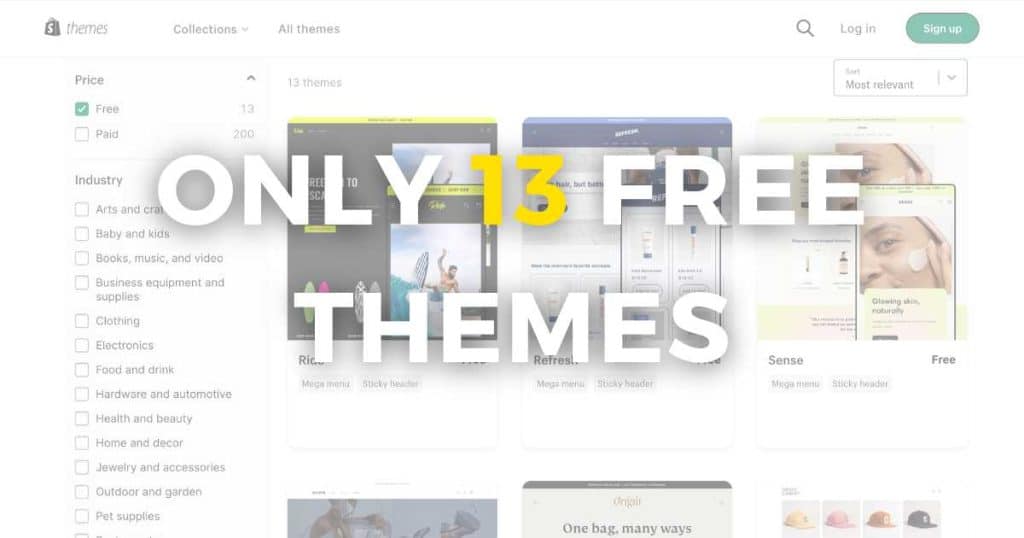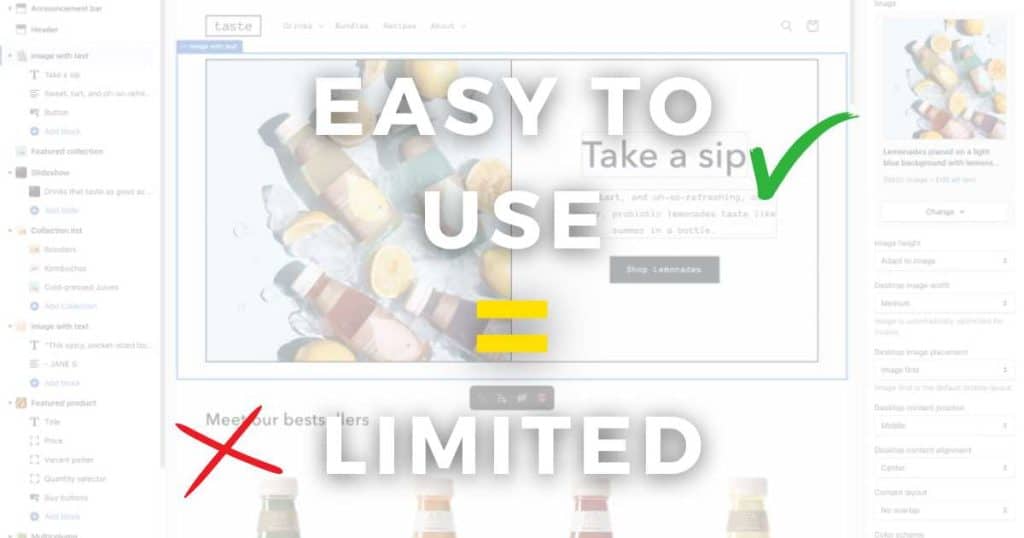In this blog post, I share my top 10 disadvantages of Shopify that you must read before buying!
Shopify is a big name in the eCommerce world. And although it is pretty impressive, there are some critical drawbacks you might not have considered yet.
By the end of this article, you should have everything you need to know to determine whether Shopify is the right choice for your online store.
Are you ready? Let’s jump in!
Read more: Top 10 Advantages Of Shopify.
What Is Shopify?

Shopify is a comprehensive, fully hosted CMS and eCommerce platform that runs over a quarter of all online stores on the Internet today.
This no-code tool is known for being beginner-friendly, functional, and scalable.
Shopify truly offers every tool you could ever wish for to start, run, and grow your online business from the ground up.
Whether designing a beautiful and responsive website, handling transactions, managing emails, or keeping track of inventory, Shopify has you covered!
Learn more about Shopify in my comprehensive Shopify guide here.
Top 10 Disadvantages of Shopify
As you can see, it’s clear why Shopify is a top choice in the eCommerce world. But does that mean it’s the best option for you? Not necessarily!
But before you decide to start selling on Shopify, you should also consider the platform’s shortcomings.
So, what are Shopify’s top 10 disadvantages? Let’s find out.
Read more: Is Shopify Good For Beginners?
1. No Free Plan

First up on this disadvantages of Shopify list is that there’s no free plan.
The good news is that the free trial allows you to test out the platform for three days, and your first month will cost you just $1.
However, after that, you must pay the full plan fee to keep your store fully functional, which can cost anywhere from $29 to $399 (depending on the plan you choose).
Other online store platforms like Wix and Ecwid provide a free forever version, allowing individuals or small teams to operate a basic online store at no cost.
Therefore, entrepreneurs on a budget (or teams who simply want to test the waters) may be better off using another online platform to manage and sell their products.
Read more: How To Delete Shopify Store?
2. Hidden Fees
Shopify has three plans—Basic ($39 per month), Shopify ($105 per month) and Advanced ($399 per month). When paid annually, each pricing plan lowers by 25%.
Sounds simple, right? Well, not quite! The actual expense only fully reveals itself once you dive deeper.
The reality hits when you discover the extra costs associated with Shopify’s App Store.
Many apps (some crucial for store functionality) also have monthly charges, ranging from a few dollars to over $30!
Plus, while Shopify offers some free templates, more sophisticated designs can cost up to $500!
Not to mention, there are additional transaction and credit card fees (for those who don’t use Shopify Payments) and yearly domain costs.
As you can see, these costs can quickly add up, with the monthly total being much higher than the original paid plan price.
Read more: Shopify vs Shopify Plus.
3. Limited Free Themes

Despite being one of the largest eCommerce platforms on the web, the number of free themes Shopify offers is another key disadvantage.
Don’t get me wrong, Shopify offers a decent selection of themes that you can use to design your online store.
However, the number of free themes is minimal. With just 13 free themes (200 paid themes), teams on a budget are very limited.
As a result, many Shopify stores typically look similar, making it challenging for your store to stand out in a crowded marketplace.
Businesses looking for more advanced or specialized design features must invest in premium themes (or hire a developer) to achieve a unique storefront design.
Read more: How To Change Shopify Store Name?
4. Limited Learning Resources
Although Shopify provides an extensive knowledge base full of how-to articles, blog posts, and video tutorials (YouTube), they’re not very easy to follow.
This is a considerable disadvantage and a missed opportunity for Shopify!
It not only leaves users feeling confused but also forces them to seek information from third-party sources.
Luckily, I’ve got you covered! Check out my full range of Shopify how-to guides, articles, and videos here.
5. Limited / Difficult Customization

Shopify’s user-friendly interface and plug-and-play setup make it an ideal choice for non-tech-savvy individuals.
The drag-and-drop structured page builder allows complete novices to build an eCommerce site. And although this means you’re less likely to make a mistake, it comes at a cost.
Unless you’re comfortable with coding, the structured page editor is limited in terms of store design.
And while it’s possible to switch to a code-only editor and personalize your theme further, Shopify uses its own coding language, Liquid, which is typically only used in Shopify.
This can be challenging for those looking to customize their store heavily, as it may involve hiring specialist Shopify developers.
If a tailored online store is essential to your brand, be prepared for the additional effort (and potentially higher cost) to achieve that level of customization on Shopify!
Read more: How To Remove Powered By Shopify On Your Website?
6. Limited Section Elements
Okay, so we’ve established that Shopify’s range of themes is limited, and the page builder is very basic. But what about actual page elements?
Well, the range of section elements ranges from theme to theme.
But compared to other website builders, the range of section elements you can choose when building your website and product pages is also very limited across the board.
Considering how much you can end up paying for themes, this is disappointing, to say the least!
Read more: How To Add a Video To Shopify Home Page?
7. No Email Hosting

Another significant disadvantage of Shopify is that it lacks email hosting capabilities.
This is an issue because an email address that doesn’t match your domain can potentially impact your brand’s professionalism and credibility.
Fortunately, you can integrate an external email hosting provider like Zoho Mail or Omnisend into your Shopify account.
But if you’re looking for a centralized email hosting and online store solution, you won’t find it within Shopify!
Read more: What Is Omnisend?
8. Limited Blog Capabilities
At its core, Shopify is an all-in-one premium eCommerce solution.
Therefore, it’s not surprising that Shopify’s content marketing features aren’t the strongest
While you can host a blog directly on your storefront, the blogging tool itself could be more sophisticated and user-friendly.
The editor is slightly clunky and can’t organize posts into categories or link related posts within new content, which are crucial features in driving traffic!
If you’re looking for a versatile blogging platform to accompany your online store, WordPress (and WooCommerce) is a more robust CMS choice.
Read more: What Are The Advantages of Shopify Over WordPress?
9. Lack of Phone Support

Despite Shopify’s 24/7 live chat support on all plans, the platform doesn’t include phone support unless you upgrade to a higher-paid plan.
This is a massive disadvantage for users who prefer the immediacy and personalized guidance of speaking to a real person over the phone.
Instead, Shopify directs its users to their support system, which includes live chat and a help center with articles and tutorials.
While this emphasizes self-help and instant online support, you must navigate the Internet to find what you want.
And as we found out earlier, their knowledge-based articles and videos actually aren’t super helpful anyway!
This can seriously deter users who value or require real-time verbal communication to resolve their issues.
Read more: Is Amazon Better Than Shopify For Selling Products?
10. Shopify Payments Isn’t Available Everywhere
Shopify Payments (Shopify’s own payment processing solution) was built to simplify the transaction process.
However, although the tool provides a seamless checkout experience and reduces the need for third-party gateways, it’s not available in all countries.
Basically, businesses located outside the supported countries must use an alternative payment provider.
This can lead to additional fees and a more complex setup process.
If you’re considering using Shopify as your online store builder provider, I suggest checking out this list of supported Shopify Payments countries before doing so.
Stews Final Thoughts
And there you go! That brings me to the end of this top 10 disadvantages of Shopify article.
There’s no doubt that Shopify is a powerful and user-friendly platform that has empowered millions to launch and grow their online stores with ease.
However, as you can see, it’s not perfect.
While these drawbacks don’t necessarily diminish Shopify’s overall appeal, they serve as reminders to assess your business needs before fully committing to the platform.
So, do you agree with my top 10 disadvantages of Shopify list? Let me know below.

